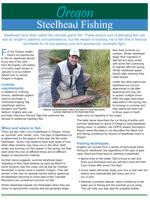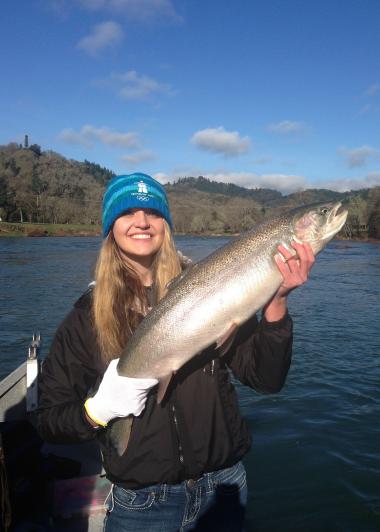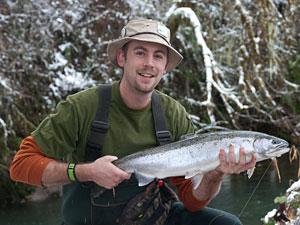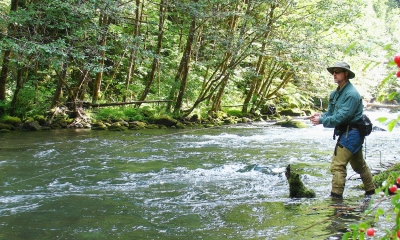
How to fish for steelhead
Steelhead have been called the ultimate game fish. These elusive and challenging fish can test an angler’s patience and persistence, but the reward is hooking into a fish that is famous worldwide for its line-peeling runs and spectacular, acrobatic fight.

For the Oregon angler, there’s an opportunity to fish for steelhead almost every day of the year – from the frigidly cold waters of a north coast stream in January to a sun-baked desert river in central Oregon.
License requirements
In addition to a fishing license, steelhead anglers need to purchase a Combined Angling Tag (steelhead, salmon, sturgeon and Pacific halibut), and, if fishing in the Columbia River Basin, a Columbia River Basin Endorsement. Anglers also can purchase Hatchery Harvest Tags that authorize the harvest of additional hatchery fish.
When and where to fish
There are two main runs of steelhead in Oregon, known as “summer” and “winter” runs. The type of steelhead run is determined by the season of the year the fish enter freshwater. Some river systems have both types of runs while other streams may have one or the other. Both winter and summer run fish spawn in the spring, but they each enter the river at different times and at different stages of reproductive maturity.
As their name suggests, summer steelhead begin migrating to their natal streams as early as March in some streams near the coast, and as late as October/November in some rivers in eastern Oregon. They will remain in the river for several months before spawning. All steelhead returning to rivers east of the Cascade Mountains are considered summer run fish.
Winter steelhead migrate into fresh water when they are closer to reproductive maturity and are generally larger than their summer-run cousins. Winter steelhead begin their migration in late fall and early winter with some fish continuing to migrate well into spring. Winter steelhead spawn shortly after entering their natal stream.
Unlike the other salmonids, steelhead are not pre-determined to die after spawning and may live to spawn multiple times. After the eggs have been deposited in the spring, the fry emerge in summer and may spend the next one to three years in fresh water prior to migrating to the ocean.
The table below describes the run timing of winter and summer steelhead on some of Oregon’s best steelhead fishing rivers. In addition, the ODFW weekly Recreation Report describes the latest river and fishing conditions for dozens of steelhead rivers in Oregon.
Oregon's top steelhead rivers
River |
Jan |
Feb |
Mar |
Apr |
May |
Jun |
Jul |
Aug |
Sep |
Oct |
Nov |
Dec |
Notes |
|---|---|---|---|---|---|---|---|---|---|---|---|---|---|
| Alsea River | XX | XX | XX | XX | Typically peaks mid Jan to mid Feb | ||||||||
| Big Creek/Gnat Creek/NF Klaskanine | XX | XX | XX | Small streams can be good when other rivers are high; primarily hatchery run mid-Nov-Jan. | |||||||||
| Chetco River and Bay | XX | XX | XX | XX | |||||||||
| Clackamas River | XX | XX | XX | XX | XX | X | X | X | X | X | XX | XX | Seasons peaks in January and March |
| Columbia River, lower | X | X | X | X | |||||||||
| Coos River | XX | XX | XX | XX | |||||||||
| Coquille River | XX | XX | XX | XX | |||||||||
| Deschutes River | X | X | X | X | X | X | |||||||
| Eagle Creek (Clackamas) | XX | XX | XX | XX | Seasons peaks in January and February | ||||||||
| Elk River (Curry Co.) | XX | XX | XX | ||||||||||
| Grande Ronde River | X | X | X | X | X | X | X | ||||||
| Hood River | XX | XX | XX | XX | XX | X | X | X | |||||
| John Day River | X | X | X | X | X | X | |||||||
| Kilchis River | XX | XX | XX | XX | XX | Primarily catch and release on wild fish late December - mid April | |||||||
| McKenzie River | X | X | X | X | X | X | X | ||||||
| Mid-Fork Willamette | X | X | X | X | X | X | X | ||||||
| Necanicum River | XX | XX | XX | XX | XX | Opportunity for hatchery fish mid Nov-early Feb.; wild fish from mid January - March | |||||||
| Nehalem River | XX | XX | XX | XX | XX | Primarily a fishery for late returning wild fish | |||||||
| Nehalem River, No. Fork | XX | XX | XX | XX | XX | XX | Opportunity for hatchery fish mid-Nov.-mid April; wild fish late Dec.-mid April. | ||||||
| Nestucca River | XX | XX | XX | XX | X | X | X | X | X | X | XX | XX | Steelhead available year-round |
| Rogue River | XX | XX | XX | XX | X | X | X | X | X | XX | |||
| Sandy River | XX | XX | XX | XX | X | X | X | X | XX | ||||
| Santiam River, So. Fork | X | X | X | X | X | X | |||||||
| Siletz River | X | X | X | X | X | X | XX | Steelhead available year-round | |||||
| Siuslaw River | XX | XX | XX | XX | Season peaks late January into March | ||||||||
| Snake River | X | X | X | X | X | X | |||||||
| Tenmile/Eel Creek | XX | XX | XX | XX | |||||||||
| Trask River | XX | XX | XX | XX | X | X | X | X | X | X | X | XX | Steelhead available year-round |
| Umpqua River, No. Fork | XX | XX | XX | XX | X | X | X | X | X | X | X | ||
| Umpqua River, So. Fork | XX | XX | XX | XX | XX | ||||||||
| Willamette River, lower | XX | XX | XX | X | X | X | XX | XX | Season peaks December - February | ||||
| Wilson River | XX | XX | XX | XX | X | X | X | X | X | X | X | XX | Steelhead available year-round |
X = summer steelhead
XX = winter steelhead
Note: Summer and winter steelhead runs often overlap to some degree in the spring and late fall in rivers with both summer and winter steelhead populations.
Fishing techniques
Anglers can choose from a variety of techniques when fishing for steelhead, but regardless of the type of gear used, there are three keys to catching a steelhead:
- Spend time on the water. Get to know a river and hone your technique, and you will land more fish than if you chase after every “hot lead.”
- Cover water efficiently. Keep your lure or bait near the bottom and methodically fish every part of a run or pool
- Maintain a positive attitude. Have confidence in the water you’re fishing and the lure/bait you’re using.
Bobber and jig/bait - This is a good technique for both bank and beginning steelhead anglers. A weighted jig or bait is tied below a floating bobber and drifted in the current. When the bobber dives, stops or wobbles, set the hook!
Drift fishing – The bait or lure is bounced along the bottom with the help of a significant weight. The key is to keep the bait near the bottom of the water and drifting along at the same speed as the current. Getting a natural presentation and detecting the subtle takes of steelhead make this a difficult technique to master. But its effectiveness makes it one of the most widely-used steelhead fishing techniques.
Plunking – A heavy weight holds bait or a spinner-type bobber stationary in the current near the bottom of a river. This is a great technique when water levels are very high and steelhead are holding or traveling in soft waters near the bank. Good for beginners or anglers with limited mobility.
Spinners – Many anglers are familiar with the cast and retrieve method, but those that master the cast and swing presentation often have better luck with steelhead. This involves casting the spinner slightly upstream and letting if drift naturally in the current and then “swing” toward the bank.
Pulling plugs (aka hot-shotting, backtrolling) – A plug is a plastic lure designed to dive and wiggle in the current. While they are often pulled behind a boat where they can move and wiggle in the water as the boat drifts downstream, plugs also can be cast from the bank and slowly swung in the current.
Fly-fishing – A challenging but rewarding technique for targeting steelhead. Anglers use single or double-handed rods to swing flies through the current, or a nymph/indicator rig to drift a nymph near the bottom.
Equipment
Most steelhead rods tend to be a little lighter and more sensitive than salmon rods. A good all-purpose rod might be an 8 ½ footer rated for 8-12 pound test line with a medium heavy action. Most experienced anglers prefer a bait casting set-up over a spinning set-up.
Of course there also are specialized rods for different fishing techniques (pulling plugs, bobber/jig, fly-fishing, etc.) and if you’re purchasing a rod for steelhead fishing you should consider a number of things:
- Type of fishing you’ll be doing the most (drift fishing, plunking, pulling plugs, etc.)
- Size of the lure to be cast
- Type of reel (bait casting, spinning)
- Size of line (#12, #20)
- Rod length (casting on large streams, small streams with lots of brush, fishing from a boat)
- Warranty
Steelhead fishing ethics
Steelhead fishing is very popular in Oregon and chances are you’re going to be sharing a run or pool with another angler. A certain steelhead fishing etiquette has evolved that helps create an enjoyable fishing experience for all. Some key elements include:
- If you’re fishing from a boat, be sure to give bank anglers plenty of room. And don’t anchor in the middle of a hole if there are people fishing it from
the bank. - Leave plenty of room between you and your neighbor on the bank. A good rule of thumb is to leave as much room as you would like another angler to leave you.
- A new angler typically steps into a pool or run upstream (or above) the other angler’s position because most steelhead anglers gradually move downstream in order to cover the entire run. If you’re not sure what direction another angler is moving, ask them. Most anglers are happy to have you follow them through a run.
- Treat all anglers the way you would like to be treated.
Header photo by Charlotte Ganskopp





